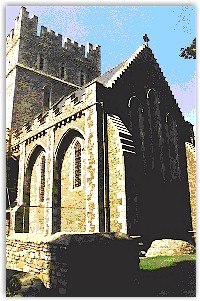County Kildare History and Heritage
Kildare Cathedral
As a place of interest both historically and religiously, Kildare Cathedral is second only to that of the Cathedral Church of Armagh. St. Brigid, the founder of the church, was born in 453 A.D., and is one of the three most famous Irish saints, along with St. Patrick and St. Columcille. A deeply religious person, even as a child, she was the first woman who engaged in church work in Ireland.
 One
of the most important events in St. Brigid’s life was the foundation
of Kildare Cathedral. The cathedral started out as a small ‘kill’ or
church, built near a great oak tree. It was from the church and tree that
the surrounding area took its name Cill-Dara "church of the oak".
This later extended to the town, county and finally diocese. And so, in
470 A.D., St. Brigid’s monastery was founded and her growing number
of converts spread throughout the land. Brigid decided that she needed
a bishop and so the person she chose was St. Conleth (also known as Hugh
the Wise) - the first bishop of Kildare. The cathedral and its adjacent
round tower reflect the style of eighth century Christian settlements.
Outside the cathedral are the remains of the ancient High Cross of Kildare.
During renovations carried out on the cathedral and its grounds, an ancient
granite font was discovered and this was placed in the nave. In 1871 restoration
work was begun as the cathedral had fallen into disrepair.
One
of the most important events in St. Brigid’s life was the foundation
of Kildare Cathedral. The cathedral started out as a small ‘kill’ or
church, built near a great oak tree. It was from the church and tree that
the surrounding area took its name Cill-Dara "church of the oak".
This later extended to the town, county and finally diocese. And so, in
470 A.D., St. Brigid’s monastery was founded and her growing number
of converts spread throughout the land. Brigid decided that she needed
a bishop and so the person she chose was St. Conleth (also known as Hugh
the Wise) - the first bishop of Kildare. The cathedral and its adjacent
round tower reflect the style of eighth century Christian settlements.
Outside the cathedral are the remains of the ancient High Cross of Kildare.
During renovations carried out on the cathedral and its grounds, an ancient
granite font was discovered and this was placed in the nave. In 1871 restoration
work was begun as the cathedral had fallen into disrepair.
Work commenced to repair the stonework, roof and floor of the nave and trancepts. This was completed in 1896. More repairs were carried out to the exterior of the building in the 1980’s. The cathedral contains many treasures, including an altar frontal designed by English artist, John Ninian Comper. The design of the frontal uses the symbolism of the story of the Patron Saint. In 1991, as part of the celebrations of the centenary of the Co. Kildare Archeological Society, some of the Cathedral treasures including the plate, were displayed.
Today work is still being carried out on the cathedral to ensure the conservation of one of Ireland’s most historical ecclesiastical buildings.

